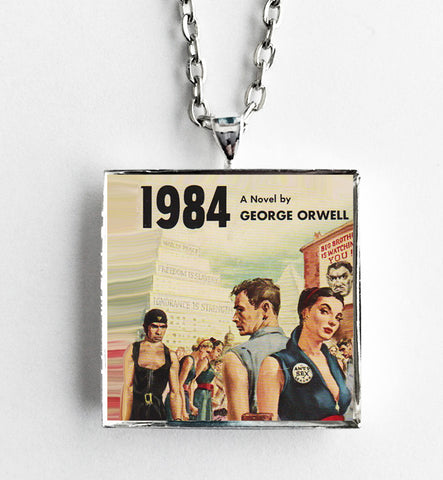

An empty chair features in the foreground, a railing runs around a veranda and the walls are slatted. Two men sit in bamboo furniture reading newspapers and taking a drink as a third man in cotton shorts and shirt stands with his back to us, gazing out into the jungle. My current favourite, however, is Burmese Days which adds more colour, pink and vegetation green and presents a more complex composition. But dominating at the right hand side of the jacket is a ruined wall seemingly being kept upright with wooden props. The houses in the back are small and squat and a line of laundry flutters. Maintaining the same colour palette and use of block colours, The Road To Wigan Pier shows three men in flat caps playing a game of some sort or maybe gambling with dice. In the bottom left, in a square of white light are the small figures of a man and a woman. One stylised window appears to be lit on the building’s ground floor and we see an aspidistra plant in outline. Keep The Aspidistra Flying uses the same block colour and thick black lines to create a building that dominates the cover – this time the colours are black, white, olive green and a shade of blue that runs as a strip down the centre of the illustration.

The colours used are black, white and olive green. What we’re seeing is the lychgate of a church and standing in front of it is a young woman – with no facial features but representative of the main character, Dorothy Hare – wheeling a bicycle. The buildings look as if they have been constructed of children’s wooden blocks while the spidery trees that slip off the front cover and onto the spine are webs of branches with no delineation of foliage. Piper’s take on A Clergyman’s Daughter makes use of rectangles and oblongs defined by thick black lines. So far I’ve managed to accumulate four of the titles but the big ones – Animal Farm and 1984 – are extraordinarily elusive. Quite why any biographical information is so hard to come by I’ve no idea and it’s a bit of a surprise really because the covers he produced for the Orwell commission are genuinely wonderful.

I have to admit that I know virtually nothing about Denis Piper other than the fact that he was born in 1928, died in 1987 and was a book cover illustrator much used by Penguin books as well as doing this work for Secker. Posted on Classic Covers: Denis Piper’s artwork for George Orwell’s novelsĪt the end of the 1950s and into the early 1960s, Secker and Warburg printed a new edition of George Orwell’s novels and commissioned the artist, Denis Piper to produce the dust jackets.


 0 kommentar(er)
0 kommentar(er)
